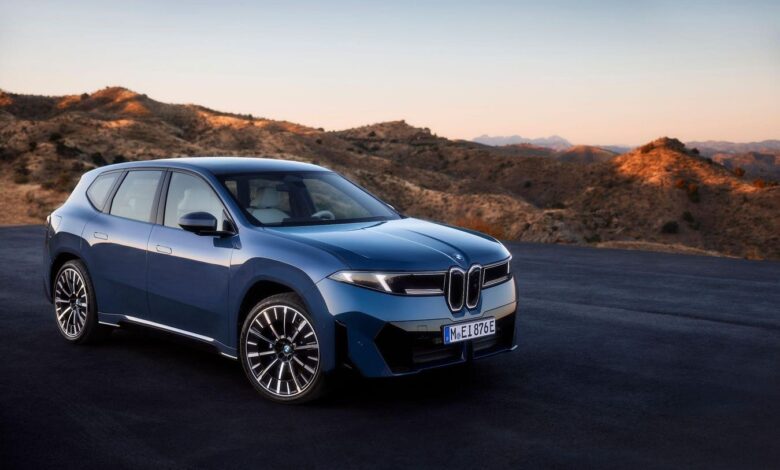2026 BMW “Neue Klasse” IX3 SUV BEV Finally Breaks Cover

📝 usncan Note: 2026 BMW “Neue Klasse” IX3 SUV BEV Finally Breaks Cover
Disclaimer: This content has been prepared based on currently trending topics to increase your awareness.
BMW’s cleanest SUV so far, the all-new “Neue Klasse” 2026 iX3 BEV boasts a range of 500 miles. Photo: BMW Group.
BMW Group
Sept 5, 1115cet
Munich: BMW has finally unveiled its long-teased 2026 BMW iX3 “Neue Klasse” electric all-wheel SUV, promising strong performance and a 20% improvement in range.
Boasting up to 805km/500 miles (WLTP) on a single charge, the 2026 BMW iX3 will be on sale in Germany next spring from €68,900 and in North America next summer, all built in Debrecen, Hungary.
There will also be a “localized” version (with a longer wheelbase and a stand-alone design) of the iX3 built in Shenyang, China, for domestic consumption in the world’s largest auto market.
The first model into production will be the BMW iX3 50 eDrive, an all-wheel drive battery electric vehicle (BEV) with 345kW of power with a 0-100km/h (62mph) sprint of 4.5 seconds.
There will also be performance versions and more economical, single-motor versions, as well as a hydrogen fuel-cell EV version.
BMW claims the iX3 will deliver energy efficiency of between 15.1 and 17.9kW/h per 100km on the WLTP cycle, and it has limited the SUV’s top speed to 210km/h. It has 60% more energy recuperation potential than its predecessor, and can activate its electric motors for both acceleration and recuperation 10 times faster than the outgoing iX3.
The size of the Neue Klasse bet by BMW is so big that it gave birth to five concept cars (The Vision Dee, the Vision Neue Klasse, the Vision Neue Klasse Next and the BMW panoramic drive) to prepare the path for the iX3.
BMW bet the farm on the “Neue Klasse” BEV architecture beneath the iX3, and it will house another 40 new models. Photo: BMW Group.
BMW Group
BMW’s Head of Sustainability Vehicle Projects Juergen Froeschl said that battery production accounted for at least half of all a BEV’s production CO2 emissions, and the 2026 iX3 creates 42% less carbon emissions per Watt-Hour than its predecessor.
“The battery is half the production CO2 cost of the car, and our Neue Klasse battery cells use 42% less carbon per Watt hour than the current iX3,” Froeschl said.
“The materials like lithium, cobalt, nickel are all 50% secondary raw materials, and we use renewable energy to make the anode and cathode, and we are working on making it even higher.”
It’s the biggest bet BMW has made on picking the future automotive sweet spot in, well, ever, according to BMW Board of Management Chairman, Oliver Zipse.
“The Neue Klasse is our biggest future project and marks a huge leap in terms of technologies, driving experience and design,” Zipse said.
“Practically everything about it is new, yet it is also more BMW than ever. Our entire product range will benefit from the innovations of the Neue Klasse – regardless of the drive technology.
“What started as a bold vision has now become reality: the BMW iX3 is the first Neue Klasse model to go into series production.
“We are not only bringing the next generation of one of our most successful fully electric vehicles onto the road, we are launching a new era for BMW.”
Technically Terrific
BMW made five separate concept cars to accustomize people to the 2026 iX3’s new visual look, and it boasts 520 liters of luggage capacity. Photo: BMW Group.
BMW Group
The sleek, smooth bodywork of the new iX3 also brings BMW’s new design language, and will be the first of up to 40 new models off the electric Neue Klasse chassis architecture.
The basics are very BMW, with a five-link rear suspension architecture and a sophisticated version of a strut front end. It’s between those zones that it gets interesting.
There are now cylindrical lithium-ion battery cells inside the floor, and BMW has them running at 698.9 Volts and delivering 108.7kWh of energy storage.
That’s good enough, on the European Worldwide Light Vehicle Test Protocol (WLTP) for 805km of range.
It will take 11 hours to charge from zero to full on a standard 11kW Alternating Current (AC) charge point or 5:45 on the optional 22kW AC setup.
It can charge at both 400kW on an 800V Direct Current (DC) charger, and that’s enough to charge from 10% to 80% in 21 minutes, and it gives between 309km and 372km from 10 minutes of charging.
It is also bidirectional, so it also has Vehicle to House (V2H) and Vehicle to Grid (V2G) discharging at 11kW and Vehicle to Load (V2L) at 3.7kW.
Design and Interior
The 2026 BMW iX3 boasts a clean interior, with a tilted multimedia screen and a full-width digital band that serves as both the instrument cluster and a multi-widget display board. Photo: BMW Group.
BMW Group
There is a new design language for the 2026 BMW iX3, with smooth, clean exterior skin and light as the new chrome.
The ever-widening stretch of the twin kidney grilles has gone, replaced by a proudly throwback upright pair, flanked by twin headlights, and it’s clear that there’s lineage between the 2026 iX3 and its 1960s forebears.
It’s 4782mm long, 1895mm wide and 1635mm high, riding on an interior-stretching 2897mm wheelbase, all riding on 225/40 R20 tires.
The slight difficulty here is that it’s still a 2285kg machine in its two-motor iX3 50 specification, which only gives it 540kg of payload, passengers included. Not that this sort of thing is unusual in the BEV world…
Inside, there is a healthy 520 liters of luggage capacity, which can be increased to 1750 liters by folding down the rear-seat backrest. There’s also that 58-liter frunk sitting above the front axle.
Environmentally Better
The 2026 BMW iX3’s interior contains 140 recycled PET bottles, amongst its very high-tech digital technology. Photo: BMW Group.
BMW Group
It will take less than a year of driving for the 2026 BMW iX3 to wipe out its production CO2 deficit to a combustion-powered X3, the Bavarian automaker claims.
BMW has gone all-in on both renewable energy and re-used raw materials to make its all-new iX3 cleaner, faster than any BEV before it, plus the SUV uses 20% less energy to drive than the current car.
With an astonishing 740kg of recovered raw materials, fully one third of the iX3 50 xDrive’s total mass will be made of pre-used aluminium, thermoplastics and other discarded materials.
The result is the cleanest BMW electric vehicle ever made, before it even turns a wheel, with reused secondary materials now used in stressed components for the first time.
”It’s a win-win,” Froeschl said.
“We keep plastics and metals out of the seas and landfills, and they take less processing energy to create the raw material,” Froeschl said.
“And these days the quality is comparable to a 100% primary material, at a much lower CO2 cost.”
BMW insists 30% of the material for the frunk is from maritime plastics, and at 58 liters, it’s a big single part.
“That’s the highest share that can be industrialized in the current supply chain. It’s limited to 30% because of the purity in the supply chain.
“The interior has to meet more quality targets – and the limit is smell – but the quality is comparable to 100% primary material and the entire car is designed for circularity,” Froeschle said.
“The seats use the same PET-derived material for the yarn, the fleece and the glue. They are monomaterial, so they are much easier and more efficient to dismantle, and the entire interior is 140 PET bottles.”
Aluminium Competence
BMW is now using recycled aluminum for stressed suspension parts as well as cosmetic pieces. Photo: BMW Group.
BMW Group
While automakers have long used secondary aluminum, it has largely been in unstressed areas, but that has changed.
“If the quality of the secondary material is right you can do it much higher percentages than what we are doing now, but it’s limited by availability of the secondary material,” Froeschl explained.
“The aluminum rims are 80% secondary material, and the wheel carriers are 70%, so now we have parts with high stress made from secondary material, without changing our material or chemical specifications. The quality of the secondary material has changed, not how we make our parts.”
BMW has chased down emissions across the board, but the move to stressed aluminum parts has lead to a huge chunk of change.
“With aluminum, we improved our competence with it,” Froeschl admitted. “We had to, to know the maximum acceptable limit.
“We did not change the recycling process. We know a very great deal about what we have to mix between corrosion and fatigue.”




